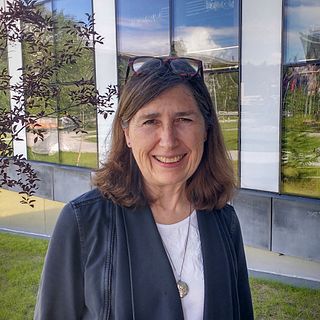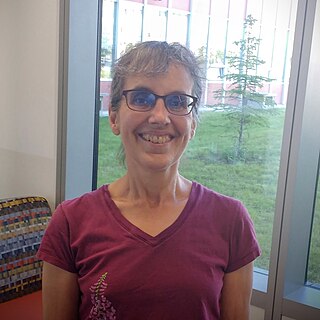Related Research Articles
Phonology is the branch of linguistics that studies how languages systematically organize their phones or, for sign languages, their constituent parts of signs. The term can also refer specifically to the sound or sign system of a particular language variety. At one time, the study of phonology related only to the study of the systems of phonemes in spoken languages, but may now relate to any linguistic analysis either:
A syllable is a unit of organization for a sequence of speech sounds, typically made up of a syllable nucleus with optional initial and final margins. Syllables are often considered the phonological "building blocks" of words. They can influence the rhythm of a language, its prosody, its poetic metre and its stress patterns. Speech can usually be divided up into a whole number of syllables: for example, the word ignite is made of two syllables: ig and nite.
Nuxalk, also known as Bella Coola, is a Salishan language spoken by the Nuxalk people. Today, it is an endangered language in the vicinity of the Canadian town of Bella Coola, British Columbia. While the language is still sometimes called Bella Coola by linguists, the native name Nuxalk is preferred by some, notably by the Nuxalk Nation's government.
In linguistics, a consonant cluster, consonant sequence or consonant compound, is a group of consonants which have no intervening vowel. In English, for example, the groups and are consonant clusters in the word splits. In the education field it is variously called a consonant cluster or a consonant blend.

Ojibwe, also known as Ojibwa, Ojibway, Otchipwe, Ojibwemowin, or Anishinaabemowin, is an indigenous language of North America of the Algonquian language family. The language is characterized by a series of dialects that have local names and frequently local writing systems. There is no single dialect that is considered the most prestigious or most prominent, and no standard writing system that covers all dialects.

Valley Yokuts is a dialect cluster of the Yokutsan language family of California.
Prenasalized consonants are phonetic sequences of a nasal and an obstruent that behave phonologically like single consonants. The primary reason for considering them to be single consonants, rather than clusters as in English finger or member, lies in their behaviour; however, there may also be phonetic correlates which distinguish prenasalized consonants from clusters. Because of the additional difficulty in both articulation and timing, prenasalized fricatives and sonorants are not as common as prenasalized stops or affricates, and the presence of the former implies the latter. Only three languages have been reported to have a contrast between prenasalized consonants (NC) and their corresponding clusters (NC).
The phonology of the Ojibwe language varies from dialect to dialect, but all varieties share common features. Ojibwe is an indigenous language of the Algonquian language family spoken in Canada and the United States in the areas surrounding the Great Lakes, and westward onto the northern plains in both countries, as well as in northeastern Ontario and northwestern Quebec. The article on Ojibwe dialects discusses linguistic variation in more detail, and contains links to separate articles on each dialect. There is no standard language and no dialect that is accepted as representing a standard. Ojibwe words in this article are written in the practical orthography commonly known as the Double vowel system.

Patricia Alice Shaw is a Canadian linguist specializing in phonology and known for her work on First Nations languages.
The sonority sequencing principle (SSP) or sonority sequencing constraint is a phonotactic principle that aims to explain or predict the structure of a syllable in terms of sonority.

Ottawa or Odawa is a dialect of the Ojibwe language spoken by the Odawa people in southern Ontario in Canada, and northern Michigan in the United States. Descendants of migrant Ottawa speakers live in Kansas and Oklahoma. The first recorded meeting of Ottawa speakers and Europeans occurred in 1615 when a party of Ottawas encountered explorer Samuel de Champlain on the north shore of Georgian Bay. Ottawa is written in an alphabetic system using Latin letters, and is known to its speakers as Nishnaabemwin 'speaking the native language' or Daawaamwin 'speaking Ottawa'.
Ottawa is a dialect of the Ojibwe language spoken in a series of communities in southern Ontario and a smaller number of communities in northern Michigan. Ottawa has a phonological inventory of seventeen consonants and seven oral vowels; in addition, there are long nasal vowels the phonological status of which are discussed below. An overview of general Ojibwa phonology and phonetics can be found in the article on Ojibwe phonology. The Ottawa writing system described in Modern orthography is used to write Ottawa words, with transcriptions in the International Phonetic Alphabet (IPA) used as needed.
Charles Reiss is an American linguistics professor teaching at Concordia University in Montreal.
Optimality theory is a linguistic model proposing that the observed forms of language arise from the optimal satisfaction of conflicting constraints. OT differs from other approaches to phonological analysis, which typically use rules rather than constraints. However, phonological models of representation, such as autosegmental phonology, prosodic phonology, and linear phonology (SPE), are equally compatible with rule-based and constraint-based models. OT views grammars as systems that provide mappings from inputs to outputs; typically, the inputs are conceived of as underlying representations, and the outputs as their surface realizations. It is an approach within the larger framework of generative grammar.

Keren D. Rice is a Canadian linguist. She is a professor of linguistics and serves as the Director of the Centre for Aboriginal Initiatives at the University of Toronto.
Heather Goad is a Canadian linguist. Her research explores areas of phonology and language acquisition, especially investigating the shapes of phonological systems, including contrasts in English, French, Korean, Portuguese, Italian and Nepali, as well as the developmental paths of acquiring speech sounds by first and second language learners.
Ellen Broselow is an experimental linguist specializing in second language acquisition and phonology. Since 1983, she has been on the faculty of SUNY Stony Brook University, where she has held the position of Professor of Linguistics since 1993.
Donca Steriade is a Romanian-American professor of Linguistics at MIT, specializing in phonological theory.
Monik Charette is a French-Canadian linguist and phonologist who taught at SOAS the University of London, in the United Kingdom. She specializes in phonology, morphophonology, stress systems, vowel harmony, syllabic structure and word-structure, focusing on Altaic languages, Turkish, and French.
Proto-Karenic or Proto-Karen is the reconstructed ancestor of the Karenic languages.
References
- ↑ "Phonology in the 21st Century: In Honour of Glyne Piggott". Linguist List. December 1, 2010. Archived from the original on April 2, 2015. Retrieved March 28, 2015.
- ↑ Piggott, Glyne (January 1991). "Apocope and the Licensing of Empty-Headed Syllables". The Linguistic Review. doi:10.1515/tlir.1991.8.2-4.287 . Retrieved March 28, 2015.
- ↑ "Editorial Information". The Linguistic Review. De Gruyter. Retrieved March 28, 2015.
- ↑ "Calls: Phonology/UK; Comp Ling, Hist Ling, Phonology/Czech Republic". Linguist List. January 26, 2007. Retrieved March 28, 2015.
- ↑ "Report of the Academic Program Review Panel on the Department of Linguistics, Memorial University" (PDF). January 8, 2009. Retrieved March 28, 2015.
- ↑ Fanfair, Ron (May 28, 2014). "Education in Caribbean should be guaranteed — Prof". Share News. Retrieved March 28, 2015.
- ↑ "About Us". Superkutz Scholarship Foundation. Retrieved March 28, 2015.
- ↑ "The Administration". The Quebec Black Medical Association. March 22, 2015. Retrieved March 28, 2015.